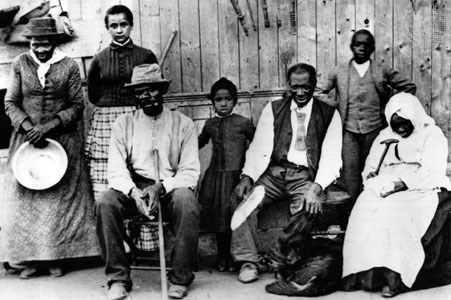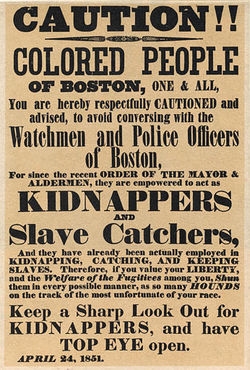 |
| Harriet Tubman (http://blog.africaimports.com/wordpress/?p=3287) |
Hopeless. Scorching, endless days of labor pass by. Helpless. Treated with no respect, property not a person. Bounded. Tied eternally to a life never desired, never wanted. During the eighteen hundreds, these were just some of the thoughts racing through the minds of hardworking slaves. In the United States, slavery was vast and distorted. African Americas were forced to become the property of white Americans with little to no exceptions. Then, the rules were broken; one woman took a stand to save the rest. She became a beacon of hope for all to see and follow to safety, Harriet Tubman. Born in 1820 on a plantation in Dorchester County, Maryland, Tubman had 11 other siblings; her parents were Benjamin and Harriet Ross. Tubman was a slave child, constantly working and suffering the common hardships of being born into an African American family during the period of Southern slavery. Her wasted childhood of tiring labor, no education and harsh punishment led her to escape slavery. In 1849, she escaped from her plantation alone. Soon after in 1850, Tubman became an official Underground Railroad “Conductor". Blacks during this time period were expected to follow someone else's rules without question, but not Harriet Tubman. She opened the eyes of Americans to a new life beyond the boundaries of slavery. She did what others did not have the courage achieve. Harriet Tubman not only used her strength and determination to successfully escape slavery and become a powerful icon in the fight against it, but she bravely took the role of a leader to guide her people to freedom, becoming a source of hope in a time of despair.
Outman, James L. "Tubman, Harriet." U.S. Immigration and Migration Reference Library. Ed. Lawrence W. Baker, et al. Vol. 4: Vol. 2: Biographies. Detroit: UXL, 2004. 389-395. Gale Student Resources In Context. Web. 15 Dec. 2010.
"Tubman, Harriet." International Encyclopedia of the Social Sciences. Ed. William A. Darity, Jr. 2nd ed. Vol. 8. Detroit: Macmillan Reference USA, 2008. 464-465. Gale Virtual Reference Library. Web. 15 Dec. 2010.
"Tubman, Harriet (1820-1913)." UXL Biographies. Online ed. Detroit: UXL, 2003. Student Resource Center - Junior. Gale. DEL NORTE HIGH SCHOOL. 15 Dec. 2010
"Tubman, Harriet Ross (c. 1820-1913)." Encyclopedia of World Biography. Thomson Gale, 1998. General Reference Center Gold. Web. 15 Dec. 2010.
 |
| Harriet Tubman and the Underground Railroad. (http://www.math.buffalo.edu/~sww/0history/hwny-tubman.html) |
By utilizing her bravery and heroic instinct, Harriet Tubman freed herself along with many others from the vicious and ruthless grasps of slavery. Tubman frees herself from slavery and begins her mission of guiding other slaves to freedom: "After her own lonely escape, Tubman became the most renowned "conductor" on the Underground Railroad. On an average of twice a year during the 1850s, Tubman traveled into the slave states, where she was widely known and where a reward was offered for her capture, to guide slaves northward to Canada. It was a dangerous task. Slave owners were highly aware that their slaves might run off, and groups of black people on the move created suspicions" (Outman, James). Harriet Tubman understood the consequences and dangers of her actions, yet she still risked her life to save others. Even with dangerous lookouts searching for her, she continued pursuing treacherous missions, putting her life on the line every second she could for the sake of others. Tubman was a spark, a starter, a leader. Her brave act of escaping slavery on her own led her to become an ideal leader in the crusade towards human's rights. Her courageous attitude and unstoppable mentality led her to rescue those in need of her help, those who were not strong enough to do it alone. And with her bravery, she gave others a role model to look up to. Tubman made treacherous journeys for the sake of others earning her the famous name of "Moses": "Tubman brought numerous freedom seekers to safety in St. Catharines, Ontario, Canada, where they became part of a growing community of refugees from slavery. Her dangerous missions won her the biblical name 'Moses'" (Ed. William A. Darity. Jr.). Tubman was a true Moses, leading her people to freedom, risking everything on faith and courage. She selflessly started this protest for those who could not. Tubman understood the dangers of her dream but knew she was strong enough to take on those challenges. Tubman helped refugees start a new and happier life. She created new opportunities for those who were afraid of living beyond slavery. Tubman's use of her brave and courageous traits to guide slaves to freedom was only the beginning of her path to becoming a true hero.
 |
| Poster from the Fugitive Slave Act of 1850 (thomaslegion.net/fugitiveslaveactof1850.html) |
Even with constant setbacks and obstacles, Harriet Tubman continued saving her fellow slaves with determination and drive like no other. She is not stopped by these new obstructions standing in her path, she figures out a way around them: "In 1850 the Federal Fugitive Slave Law was reinforced with a clause that promised punishment to anyone who aided an escaping slave. In addition, a price of $40,000 was set for Tubman's capture. Thus she began transporting some slaves past the North to refuge in Canada" (Thompson, Gale). She didn't care what stood in her way, Tubman had already came this far and was determined to make it to the end. Any obstacle in her path met no match to her drive and willpower for her human’s rights cause. These barriers were mere pebbles compared to her purpose and were simply pushed aside. Tubman knew what had to be done and was ready to continue fighting for the right as long as the wrong stood. Even though she had been wanted in many places, she didn't look at this as a negative, she worked it to her advantage. Harriet Tubman had her mind set and was not changing it until she was satisfied. When Harriet's owner passed away, she escaped through the Underground Railroad to freedom: "Upon Brodess's death in 1849, Tubman determined to take her own liberty rather than risk being sold to settle Brodess's debts. She tapped into an Underground Railroad network operating on the Eastern Shore of Maryland: Using the North Star and assistance from white and black helpers, she found her way to freedom in Philadelphia. Once safely there, Tubman worked as a domestic to support herself and save enough money to help family and friends escape from the Eastern Shore of Maryland" (Ed. William A. Darity, Jr.). Tubman made a quick and intelligent decision. She knew if she stayed her chances of being free would be severally scarce. She made a choice and stuck with it. Tubman became committed to her aspiration once she left and was driven to work until it was achieved. She put much effort and thought into this escape. Though not aware at the time of the crusade she would start, she knew no man, no law, nothing would bring her down. Tubman's determination drove her to crumble the obstacles holding her back and committed her to continuing this crusade she had sparked.
 |
| Harriet Tubman at age 91 (en.wikipedia.org/wiki/Template:POTD/2009-02-18) |
With drive and compassion, Harriet Tubman became a beacon of light for the enslaved to follow, a symbol of courage and hope for those with none, a determined women looking to impact her society for the better, a true hero. Tubman knew what it was like to be helpless, hopeless, tied to a life never desired, but she tore free of that. And when she broke her constricting chains, others began to do the same, similar to a row of falling dominoes; one after the other began falling out of slavery and into a new, free life. She never stopped, delayed at times but always seemed to pursue on with the same drive as she did in the beginning. Others depended on her to continue her brave missions so they could one day follow her footsteps, knowing that freedom was ahead. Harriet Tubman lived her life to the fullest, leaving her mark on society forever, reminding us of the drive and passion she put into her fight against slavery. No matter what barrier thrown her way, she wouldn’t give up and continued her fight. This shows how Tubman is an inspiration, because she committed herself to becoming a leader in this life, bravely took a stand to what was wrong no matter who told her otherwise. Tubman decided to take matters into her own hands, determined to save her fellow slaves in the South. She held what any hero should always grasp, the courage to take a stand for what is truly right and what matters most and the determination to risk it all in order to make that dream a reality.
Page created on 1/19/2011 12:00:00 AM
Last edited 1/19/2011 12:00:00 AM
